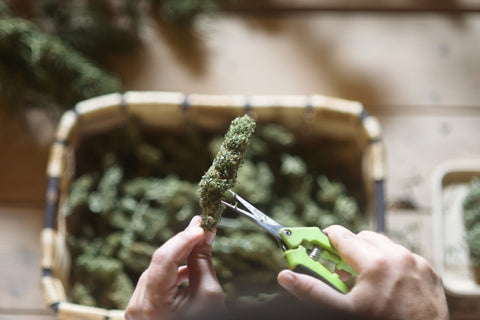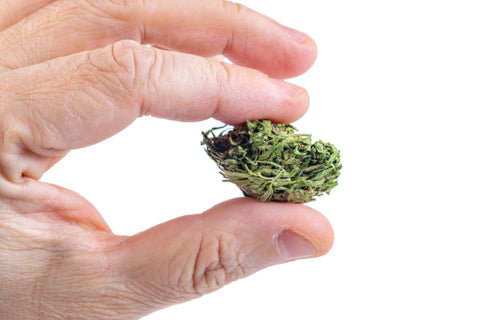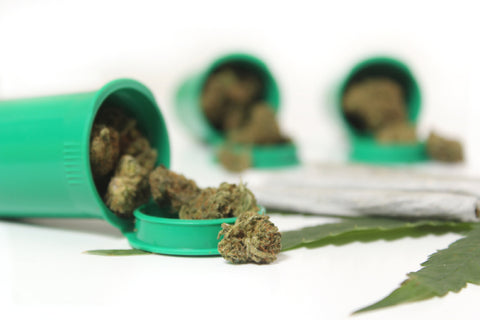Best price on the market

Prevent and eliminate mold on cured buds
In the world of cannabis cultivation, the curing process is as crucial as the cultivation itself. Proper curing not only enhances the aroma and flavor of the buds, but is also essential for preserving their quality and longevity. However, one of the most significant challenges during this process is the appearance of mold. Mold on cured buds not only compromises the quality of the product, but also poses a health risk. Therefore, it is essential to understand how to prevent this phenomenon and, if it appears, know how to handle it safely and effectively.
Fungal buds on drying can be an early sign of bigger problems during the curing process. Recognizing and addressing these issues early on is vital to ensuring bud integrity. Additionally, in situations where mold has already appeared, it is crucial to know how to remove mold from dried buds without putting the consumer's health or the quality of the product at risk.
To prevent and eliminate mold on cured buds, ensure a relative humidity of 62% and good ventilation during curing. Inspect regularly and, if there are signs of mold, discard affected buds to protect the rest.
Mold on Cured Buds
Mold on cured buds is a major concern for any cannabis grower. But what exactly is mold and why does it appear on cured buds? Mold is a type of fungus that grows in humid and poorly ventilated environments. In the case of cannabis buds, this can happen when the curing process is not done correctly, maintaining inadequate humidity levels. Mold can develop both in the initial stages of curing and during prolonged storage, especially if the buds are not dry enough or if they are stored in conditions that encourage fungal growth.
It is vital to differentiate mold from trichomes, which are natural crystalline structures present in cannabis buds and are often a sign of high quality and potency. While trichomes are shiny and sticky to the touch, with a crystalline or milky appearance, mold has a rather spongy or cottony appearance and is usually white, green or black in color. Additionally, mold can emit a musty or earthy odor, very different from the characteristic aroma of trichomes.
Understanding these differences is crucial to ensuring both the quality and safety of cured buds. An error in identification can lead to consuming a product that is not only of inferior quality but also potentially harmful to health. Therefore, learning to recognize and prevent mold is an essential step for any cannabis grower or consumer.

Common Causes of Mold on Buds During Drying and Curing
Mold development on cannabis buds during the drying and curing phases can be the result of several environmental and handling factors. Understanding these causes is essential to prevent the appearance of "dry fungal buds." Below, we look at the conditions that encourage fungal growth and how to identify and prevent these problems:
- High Humidity : The most critical factor is humidity. High humidity levels can create an ideal environment for mold growth. During drying and curing, it is essential to maintain the relative humidity (RH) in an optimal range, generally between 59% and 63% .
- Insufficient Ventilation : Inadequate ventilation can lead to the accumulation of humid air around the buds, promoting mold growth. It is crucial to ensure constant and effective air circulation in the drying and curing area.
- Inappropriate Temperature : Temperatures that are too high can accelerate mold growth. Maintaining a stable temperature, preferably between 18°C and 22°C, is ideal during drying and curing.
- Improper Storage : Storing buds in airtight containers before they are completely dry can lead to moisture buildup and, therefore, mold.
- Excessive Handling : Handling buds frequently during drying and curing can damage them and expose them to contamination, increasing the risk of mold.
- Visual and Olfactory Inspection : "Mushroom dried buds" often have a spongy or cottony appearance and may have a musty or earthy odor, very different from the characteristic aroma of cannabis.
- Preventive Measures : To prevent mold, it is essential to control humidity and temperature, ensure good ventilation, avoid premature storage and handle the buds as little as possible. Additionally, performing regular inspections can help detect signs of mold early.
Preventing Mold in the Curing Process
The curing process is crucial to ensure the quality and longevity of cannabis buds. Proper curing technique not only improves flavor and aroma, but is also essential to prevent mold formation. Below are tips and techniques for effective curing:
- Proper Initial Drying : Before beginning curing, the buds must be dried properly. This usually involves hanging the plants or branches in a controlled environment until the stems break when bending, but without the flowers falling apart.
- Humidity Control : The relative humidity of the curing site should be maintained between 59% and 63%. Dehumidifiers or humidifiers can be used to adjust humidity levels as needed.
- Constant Temperature : Maintain a constant temperature between 18°C and 22°C. Higher temperatures can accelerate mold growth, while lower temperatures can slow the curing process.
- Using Suitable Containers : Cure the buds in airtight containers, preferably glass. Containers should be filled three-quarters full to allow adequate air circulation.
- Regular Ventilation : Open curing containers daily for the first few days to allow moisture to escape and fresh air to enter. This practice, known as "burping," is essential to prevent moisture buildup and prevent mold.
- Visual and Olfactory Inspection : During curing, regularly inspect the buds for signs of mold. A musty or earthy smell, or a spongy or cottony appearance to the buds, are indicative of mold.
- Avoid Direct Sunlight : Cure the buds in a dark place to avoid degradation of the cannabinoids and terpenes.
- Use of Hygrometers : Place hygrometers inside the containers to monitor humidity. This helps adjust the conditions of the curing environment precisely.
- Cleaning and Hygiene : Maintain a clean and disinfected environment for curing, as mold and other pathogens can proliferate in dirty environments.
- Curing Duration : The curing process should last at least two weeks, although many growers prefer to extend it to four weeks or longer to improve quality.

How to Identify and Manage Buds Affected by Mold
Correctly identifying and handling mold-affected buds is crucial to ensuring the safety and quality of your cannabis. Below is a guide to identifying mold on cured buds and best practices for handling and disposal.
Identification of Mold in Cured Buds
- Visual Appearance : Mold on buds usually appears as spongy or cottony spots or layers. It can be white, green, gray or black. Unlike trichomes, which are crystalline or milky and uniformly cover the bud, mold appears in irregular spots.
- Odor : Mold-affected buds often emit a musty, earthy, or musty odor, which is noticeably different from the natural aroma of cannabis.
- Texture : To the touch, moldy buds may feel moist or sticky in an unnatural way. While trichomes give a sticky but dry feeling, mold feels moist.
- Using Ultraviolet Light : Ultraviolet light can help identify mold, as it often glows under this light.
Management and Disposal of Affected Buds
- Do Not Consume Moldy Buds : You should never consume moldy buds, as it can be dangerous to your health, especially for people with compromised immune systems or allergies to mold.
- Wearing Gloves and Mask : When handling moldy buds, it is advisable to wear gloves and a mask to prevent inhalation of mold spores and avoid cross-contamination.
- Isolation : Immediately separate affected buds from healthy ones to prevent the spread of mold.
- Safe Disposal : Moldy buds should be discarded safely. It is recommended to wrap them in plastic before discarding them to prevent the spread of spores.
- Cleaning the Storage Area : After removing moldy buds, thoroughly clean the storage area and containers used to prevent future contamination.
- Inspection of Remaining Buds : Thoroughly check the remaining buds to ensure they are not affected.
- Consideration of Total Discard : In severe cases, it may be necessary to discard the entire crop if mold has contaminated extensively, as health and safety must be the priority.

Methods to Remove Mold from Dry Buds
Importantly, attempting to “clean” or remove mold from dried buds is generally discouraged due to health risks. However, for informational purposes, we will explore some methods that have been discussed and evaluate their risks and limitations.
Discussed Methods for Removing Mold
- Careful Trimming : Some growers choose to trim mold-affected areas. However, this is risky as the mold spores may have spread beyond the visibly affected areas.
- Bud Washing : There are techniques such as washing with a solution of water and hydrogen peroxide. The bud is briefly immersed in the solution and then dried completely. Although this method may reduce the visibility of mold, it does not eliminate potentially dangerous spores or toxins.
- Exposure to Ultraviolet Light : Ultraviolet light can kill some forms of surface mold. However, it does not penetrate deeply into the bud and therefore does not completely eliminate mold or its spores.
- Heat Application : Some suggest using heat, such as a low-temperature oven, to kill mold. Although heat can kill some spores, it also significantly degrades the quality of cannabinoids and terpenes.
- Using Alcohol Solutions : Spraying buds with isopropyl alcohol has been mentioned as a method for killing mold. However, this can be dangerous and will probably ruin the product.
Risks and Limitations
- Health Risk : None of these methods guarantee complete removal of mold spores and toxins, which can be harmful to health, especially for people with weakened immune systems or respiratory problems.
- Product Deterioration : Most of these methods can negatively alter the quality, flavor, and chemical profiles of the buds.
- Ineffectiveness Against Toxins : Some types of mold produce mycotoxins, which are toxic substances that are not eliminated by these methods.
- Spore Spread : When attempting to clean mold, there is a risk of spreading the spores to other areas or products.
Long-Term Strategies for Preserving Mold-Free Buds
Keeping cannabis buds mold-free during long-term storage is key to preserving their quality and potency. Here I present a series of tips, tools and recommended products to achieve this goal:
Storage Tips
- Humidity and Temperature Control : Maintain an environment with a relative humidity between 59% and 63% and a constant temperature around 21°C. Environments that are too humid or hot can encourage mold growth.
- Suitable Containers : Use airtight, opaque containers for storage. Glass containers are preferable as they do not emit gases and keep the buds safe from light and air.
- Avoid Direct Light : Store buds in dark places to protect them from light, which can degrade cannabinoids and terpenes.
- Minimize Air Exposure : Open containers as little as possible to avoid the entry of fresh air, which can bring in moisture and mold spores.
- Regular Inspections : Periodically check the buds for early signs of spoilage or mold.

Recommended Tools and Products
- Hygrometers and Thermometers or Thermo-hygrometer : Essential tools for monitoring humidity and temperature inside storage containers.
- Humidity Control Packs : Such as Boveda 62 curing packs that help maintain a constant relative humidity within containers.
- Cannabis Specific Containers : There are containers designed specifically for cannabis storage that offer an airtight seal and protection from light.
- Desiccants : In particularly humid climates, desiccants can be used to absorb excessive moisture. However, they should be used carefully so as not to overdry the buds.
- Vacuum Preservers : Some growers choose to use vacuum systems to seal their buds. This reduces exposure to air and keeps the buds in a controlled environment.
- Dark or Opaque Packaging : Protects the buds from direct sunlight and the degradation of cannabinoids.
- Refrigeration : For very long storage, some experts recommend refrigerating the buds. However, this should be done with caution to avoid condensation and increased humidity.
- Climate Controlled Chambers : For large-scale growers, climate controlled chambers can be a valuable investment, allowing precise control of the storage environment.